Members of the United States military are eligible for several benefits during and after their service. Some of the most enticing benefits are VA education benefits, which give active duty service members, veterans, and, in some cases, their dependents, financial aid to begin or further their education. These benefits are put in place by the Department of Veterans Affairs (VA).
9 VA Education Benefit Programs
- Post-9/11 GI Bill
- Montgomery GI Bill-Active Duty (MGIB-AD)
- Montgomery GI Bill-Selected Reserve (MGIB-SR)
- National Call to Service (NCS)
- Survivors’ and Dependents’ Educational Assistance (DEA)
- Reserve Educational Assistance Program (REAP)
- Post-Vietnam Era Educational Assistance Program (VEAP)
- Yellow Ribbon Program
- Veteran Readiness and Employment Program (VR&E)
Higher education comes at a steep cost. Enrollment in an institution of higher learning can incur hefty fees in addition to the cost of tuition and materials. The U.S. Department of Veterans Affairs seeks to lessen the financial burden associated with higher education through several VA education benefits for each service member and their families.
These VA education benefits are available to eligible service members and veterans in addition to other VA benefits, like housing allowance, service-connected disability compensation, and surviving spouse benefits. With these educational assistance programs in place, active duty service members and veterans can reap the benefits of higher education without going into debt.
The VA ensures stability for veterans after they end their service through programs like disability benefits for disabled veterans and veteran’s pension programs. The VA also has several educational benefit programs available to those who have served or are serving in the military.
VA education benefit programs are designed for different reasons for active duty service members and eligible veterans. Service members and Vets can enlist the help of a Veterans Service Officer (VSO) to help you file a claim for many veterans benefits, including veteran education benefits. The following information details each program, who it helps, and what it can do for you.
Post-9/11 GI Bill
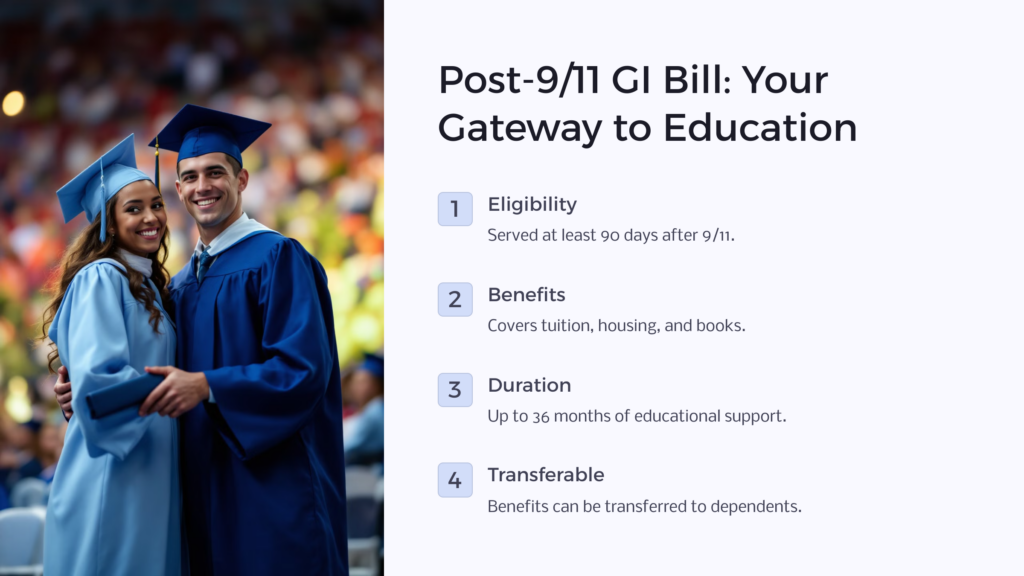
The Post-9/11 GI Bill helps active duty service members and veterans pay for school or job training. This benefit is available to those who served on or after September 11th, 2001, for at least 90 days of active duty service. Those with honorable discharges from service at least 30 days after 9/11, service members with honorable discharges who received a Purple Heart on or after 9/11, and dependents of eligible service members may also receive these benefits.
The Post-9/11 GI Bill remains in effect for up to 15 years after your separation date from active duty service if your service ended before January 1st, 2013. If your service ended after this date, your benefits become part of the Forever GI Bill, meaning that your VA educational benefits under the bill won’t expire.
This bill allows you up to 36 months of benefits that can cover your college or vocational program tuition and fees, school-related moving expenses, a monthly housing allowance, and books and supplies. The amount you qualify for depends on how much time you’ve served since September 10th, 2001. These VA education benefits cover undergraduate and graduate degrees, certificate programs, distance learning programs, and several other types of higher learning.
An active duty service member or veteran may choose to transfer their Post-9/11 GI Bill benefits to their military spouse or child. You may transfer the full 36 months or a portion of it to your dependent.
Montgomery GI Bill-Active Duty (MGIB-AD)
The Montgomery GI Bill Active Duty (MGIB-AD) is specifically for service members who have served at least two years on active duty in the United States Military. Eligibility can come in many ways, so long as the service member meets the conditions of at least one of the four eligibility categories.
Generally, this VA benefit requires a service member to have a high school diploma, GED, or at least 12 hours of college credit. They must also meet the requirements for the time during which they entered and remained in active duty service. You can view a list of the four qualifying categories and their criteria on the VA’s website.
MGIB-AD pays up to 36 months of benefits toward your tuition as a student in a degree program, certificate program, or other educational or vocational rehabilitation program. The amount of these VA education benefits you receive depends on the type of program in which you’re enrolled, your qualifying service time, the eligibility category you belong to, and other factors.
You’ll need to apply for MGIB-AD education or training benefits if you believe you’re eligible within one of the categories. After applying, you will also need to work with your school or training program to verify and certify your benefits. It’s a good idea to speak with your school’s admissions or financial office before enrolling to let them know about your plan to use MGIB-AD benefits.
Montgomery GI Bill-Selected Reserve (MGIB-SR)
The Montgomery GI Bill-Selected Reserve (MGIB-SR) educational benefit has a similar goal as MGIB-AD, but it’s for a different group of service members. MGIB-SR is targeted solely to members of the Selected Reserve of the Army, Navy, Air Force, Marine Corps, and Coast Guard, and the Army and Air National Guard.
Since this bill covers a specific group of military service members, you won’t need to fit within an eligibility category to gain benefits. Instead, you just need to prove your eligibility as a Reserve member of your selected branch and have a six-year obligation in the Selected Reserve.
Like the MGIB-AD, you can receive up to 36 months of VA education benefits. The maximum allowed payment is currently $384 per month. Selected Reserve members may have their eligibility extended if they’re called to active duty service. Typically, your time will be extended by the length of time you remain in active duty service.
Only specific types of programs may be eligible for these VA education benefits, so it’s important to check with your school before enrolling to ensure that your program is eligible for MGIB-SR. You can also use the GI Bill Comparison Tool to see if your program is covered.
To apply, submit an online or paper application. Then, have your benefits certified by your school to apply them to your tuition or program costs.

National Call to Service (NCS)
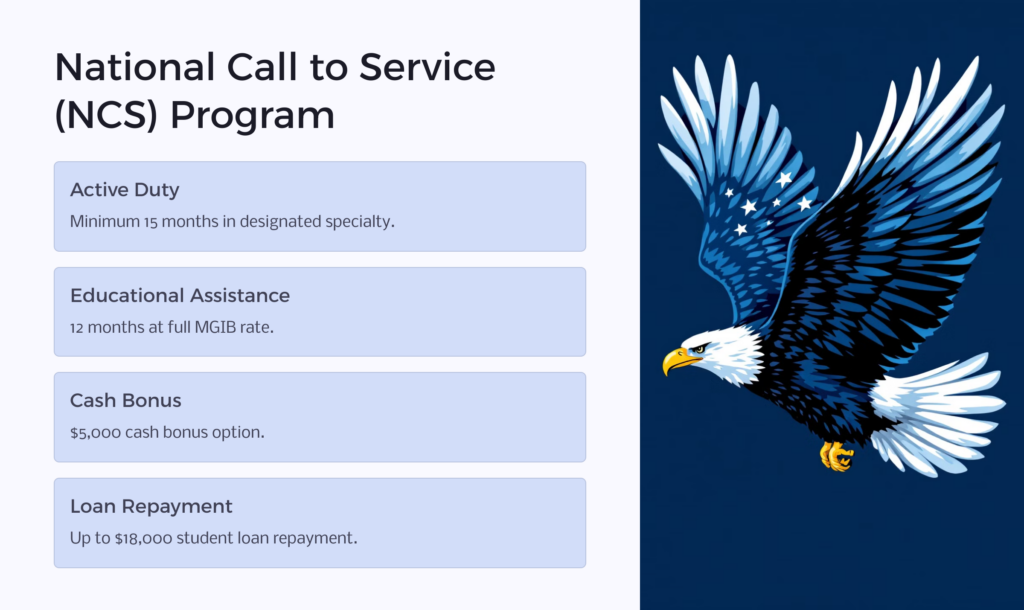
The National Call to Service (NCS) program is for those who have served in active duty for at least 15 months in a military occupational specialty designated by the Secretary of Defense, followed by another period of active duty or 24 months in the Selected Reserve. An eligible servicemember has a few options for claiming this benefit:
- 12-month educational assistance equal to the 3-year monthly Montgomery GI Bill rate
- 36 months of educational assistance equal to 50% of the less-than-3-year monthly Montgomery GI Bill rate
- A $5,000 cash bonus
- Qualifying student loan repayment of up to $18,000
If you choose to receive benefits under the NCS program, you will not be able to claim additional VA education benefits through the Montgomery GI Bill options. However, if you’re later found to be eligible for these VA benefits under chapter 1606 or chapter 30, you may be able to claim them, less the benefits already paid to you through the NCS.
If you aren’t sure which path to take or what options you’re eligible for based on your service, you should seek the help of a VSO. Your VSO can provide guidance based on your training, service eligibility, and other factors to determine what veteran education benefits are right for you.
Survivors’ and Dependents’ Educational Assistance (DEA)
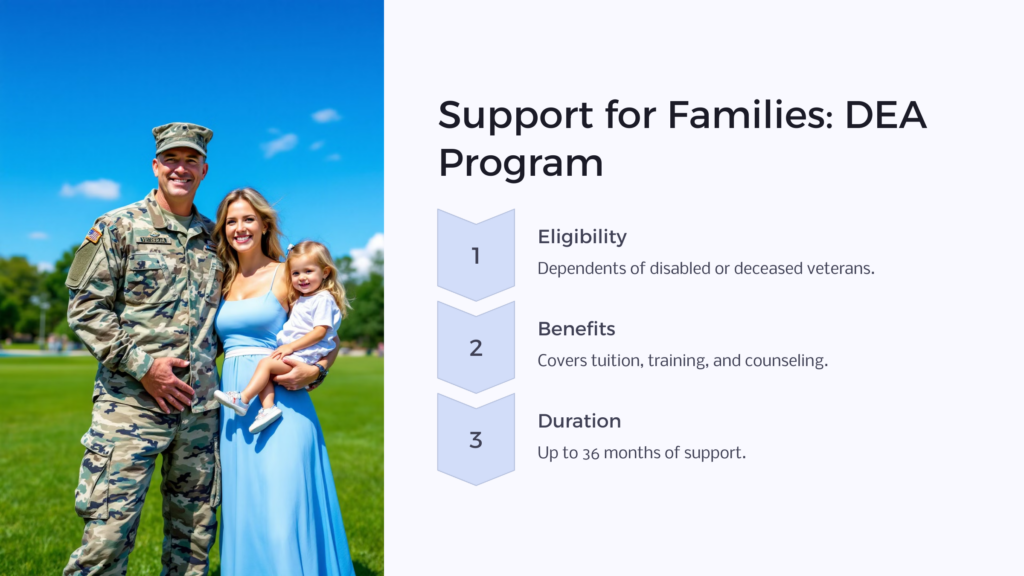
As a veteran or service member of the military, you have benefits that may cover your eligible dependents as well. The Survivors’ and Dependents’ Educational Assistance (DEA) program allows an eligible dependent (spouse or child) to also collect VA education benefits for their time as a student in a degree or vocational rehabilitation program.
VA dependents must meet eligibility criteria along with the veteran or servicemember. Servicemembers are eligible if they are disabled or have died due to a service-connected disability, were captured or forcibly detained in the line of duty, or meets other eligibility criteria as outlined here.
Eligible children of the service member or veteran may receive VA education benefits through the DEA when they’re between the ages of 18 and 26. If the child joins the military, they can use the benefit after they end their service, so long as they have an honorable discharge. Eligible spouses may qualify for the benefit for up to 20 years, whether the service member or veteran has died or was rated permanently and totally disabled.
This specific VA benefit may cover on-the-job training, certificate courses for career training, educational and career counseling, and college tuition for degree programs. The benefits currently last for up to 36 months. You or your VA dependent can apply for DEA online or by mail, and you’ll need to have your employer or school fill out paperwork to process your benefits.
Reserve Educational Assistance Program (REAP)
The Reserve Educational Assistance Program (REAP) is a standalone educational benefit program, meaning that you can’t use it in combination with other VA education benefits. This is another federal VA program that targets those in a Reserve component of the U.S. military. Specifically, Reserve servicemembers who have been called to serve as a response to war or a national emergency may use this benefit.
The REAP benefit increases regularly to offset the rising costs of education. Eligible servicemembers may receive up to 18 months of benefits. The most significant qualifying factor for REAP benefits is active duty service of at least 90 days on or after September 11, 2015. However, the Department of Defense and the Department of Homeland Security determine final eligibility for each active duty service member.
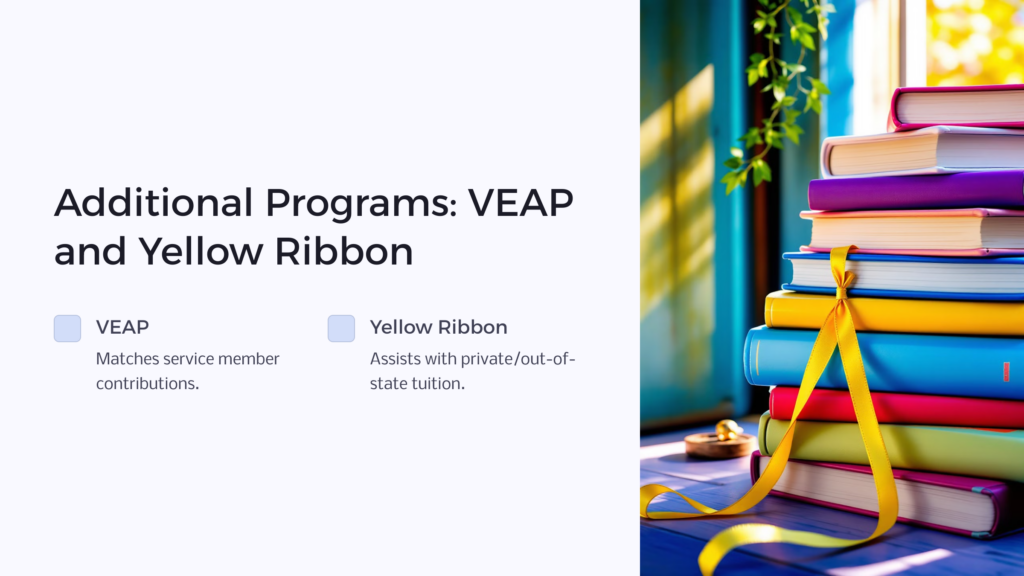
Post-Vietnam Era Educational Assistance Program (VEAP)
The Post-Vietnam Era Educational Assistance Program (VEAP) assists service members who want to become students with their education costs. This program contributes money toward a servicemember’s education if that servicemember contributed money from their active duty pay toward a VEAP savings account. The contributions must have been made before April 1st, 1987 to qualify.
The service member must have contributed between $25 and $2700 in their account. The benefit matches the contributions of the servicemember with a $2-to-$1 ratio. In other words, the VA pays $2 for every $1 you contributed. You can use this money for tuition for a degree program, certificate program, or job training program. Like other VA education benefits, it’s important to ensure that your education or training program is approved before enrolling.
You can also request for your current program to start receiving benefits if you’ve already enrolled. To do so, you’ll need to send a benefit and enrollment certification form to your school or employer to fill out and send back to the VA.
Yellow Ribbon Program
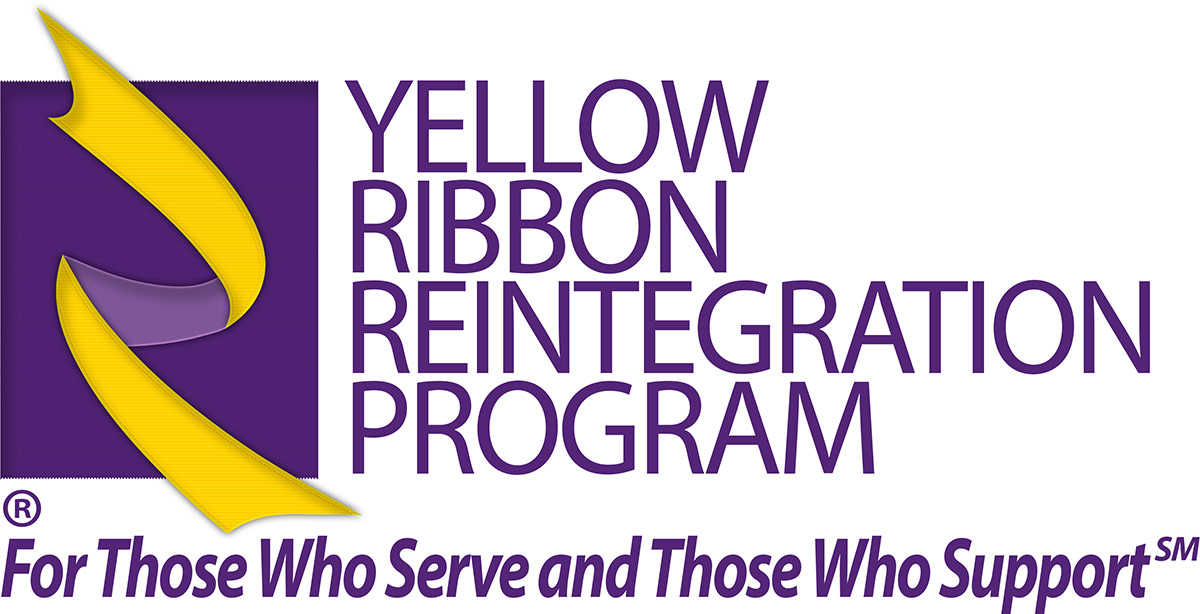
The Yellow Ribbon Program seeks to help service members and veterans who qualify for GI Bill benefits but are not enrolled or enrolling in a qualifying school. This program provides financial assistance for those seeking higher learning at a private school or a public school as a nonresident. These situations tend to lead to higher tuition costs that aren’t covered under other VA education benefits programs.
The Yellow Ribbon Program is one that schools must participate in for the program to pay assistance to the veteran or service member. Each participating school will also have a maximum number of students able to receive the benefits concurrently. If it reaches its maximum allowable number of students, additional veterans and servicemembers seeking the benefit cannot receive assistance through that school.
To be eligible, you must meet certain criteria as required by the VA, including at least 36 months of active duty service or service for at least 30 continuous days on or after September 11th, 2001. If you’re found eligible after applying, you should submit an enrollment certification request with your school to begin receiving benefits. The benefits come in the form of a grant, scholarship, or similar reimbursement program through your school, which the VA matches.
Veteran Readiness and Employment Program (VR&E)
The Veteran Readiness and Employment Program (VR&E) used to be called the Vocational Rehabilitation and Employment Program, so you may still see it referred to as such. The program remains the same and focuses on the same goal: to provide assistance to veterans and servicemembers who want to begin a new career, further their current career, or start their own business.
This VA benefit is specifically for veterans who have a service-connected disability. If you have a disability that was caused or made worse by your time in service, learn how to file a disability claim through the VA. The VA will need to determine at least a 10% disability rating to qualify you for VR&E services. You must also have an honorable discharge from your service to receive benefits.
You can be eligible for benefits within 12 years after your separation date or the date you received your disability rating. The benefits can vary significantly, depending on your goals. You can receive services like on-the-job training, resume development, vocational or technical school training, and business consulting. Most service members and veterans complete a comprehensive career and skills evaluation first through the program to determine what services might suit them best.
Other Military Education Benefit Programs
There are a few other ways that you may qualify for education benefits before or after enrollment in a degree program or vocational training program, including receiving college credits for military training and participating in state-level programs.
DoD’s Tuition Assistance (TA) Program
The Department of Defense (DoD) has its own Tuition Assistance (TA) program available to military service members. Service members in the Navy or Army earn this benefit after they’ve completed one full year of service at a duty station, while other branches have their own eligibility requirements for the benefit.
The TA covers tuition and fees for a degree program for up to $250 per credit hour for up to $4500 per year. The funds go directly to your college to offset your tuition costs. Any remaining fees and tuition will be your responsibility to pay out-of-pocket or with your scholarships, grants, loans, or other financial aid.
You may use this benefit for yourself, your spouse, or your dependent children in the state y
u reside or are permanently stationed. Currently, the TA program does not pay for out-of-state tuition.
Tuition Assistance Top Up
The Top Up program coincides with the DoD TA program. This benefit assists service members who are already using the TA program to pay for some of their tuition, but tuition and fees cost more than their TA benefit pays. The Top Up program allows you to receive more funds to cover your costs for up to 36 months.
To be eligible for this program, you must also be eligible for the Post 9/11 GI Bill or the MGIB-AD, as outlined above. You can use one of these programs and the Top Up benefit at the same time. Top Up assistance will either go to you or your school, depending on the other program you’re using. Both veterans and active duty service members may qualify for Top Up assistance.
This program can also come in handy for covering the costs of just a few courses while you complete your military service. Using minimal Top Up benefits can help you retain more of the GI Bill benefits that you’ll have upon your service completion.
College Credit for Military Training
The DoD also partners with the American Council on Education (ACE) to give college credit to people who have received military training or experience. College credit becomes part of the servicemember’s Joint Services Transcript (JST), which showcases their earned college credit based on their military training and experience.
You can show your JST to schools and training programs to apply credit you’ve received to your program. This can essentially shave time and money off the program by allowing you to waive required courses that you already have relevant credit for. To receive your JST, you can create a free JST online account, fill in your information, and request your transcript.
Not all colleges, universities, and vocational training centers recognize the JST. Therefore, it’s important to speak with an academic advisor at the school in which you’re interested before enrolling to determine whether your credits will transfer.
State-Level Education Programs
In addition to VA education benefits and DoD assistance, state-level education programs exist to help veterans and servicemembers get the education they want and deserve. These benefits are usually in the form of scholarships, grants, and tuition waivers, although they can come in other forms of financial aid.
For example, Georgia offers a program to National Guard servicemembers to cover up to $3,643 of tuition per year. This can be used in addition to other VA education benefits, providing more coverage for the full cost of tuition. Maryland features several programs for servicemembers and veterans, including tuition assistance for veterans and their dependents if they choose to enroll in a higher learning facility within Maryland.
To determine what benefits are available in your state, check with its Department of Education or regional accrediting body. Many state-level benefits can be for permanent residents or service members who are stationed in that state for active duty.
Find the Right VA Education Benefits for You
As a service member or veteran of the armed forces, you have multiple VA education benefits for which you may qualify. However, it’s important to find the one that’s right for you, as most of them can’t be used at the same time. Speak with your VSO to determine which program is the best fit for your educational and career goals.
 Benefits.com Advisors
Benefits.com Advisors
With expertise spanning local, state, and federal benefit programs, our team is dedicated to guiding individuals towards the perfect program tailored to their unique circumstances.
Rise to the top with Peak Benefits!
Join our Peak Benefits Newsletter for the latest news, resources, and offers on all things government benefits.





















